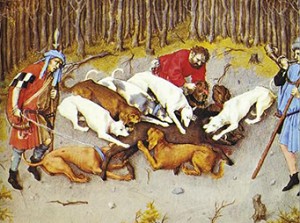History of Hunting
212 – September, 2017
text and illustrations by Ria Hörter
 In the Early Middle Ages (5th to 13th century), hunting was necessary for providing a source of food, and was part of daily life. By the Late Middle Ages (14th and 15th centuries), hunting had become a noble pastime in particular – a privileged social event for royalty and the aristocracy, but also an important preparation for war. In almost every aspect of medieval hunting, dogs played a role.
In the Early Middle Ages (5th to 13th century), hunting was necessary for providing a source of food, and was part of daily life. By the Late Middle Ages (14th and 15th centuries), hunting had become a noble pastime in particular – a privileged social event for royalty and the aristocracy, but also an important preparation for war. In almost every aspect of medieval hunting, dogs played a role.
Serf, Farmer, Nobleman and Clergy
Important events in the Middle Ages were the development of agriculture, the rise of cities, expansion of markets and trade, the position of serfs, farmers, nobility and clergy, and the development of religious art into secular art.
People suffered from pestilence, hunger, want and endless wars. The differences in society were huge; serfs and farmers hungered, noblemen and clergy had a deca- dent, luxurious life. These glaring contrasts were in every part of medieval Europe.
After the Roman laws, large parts of Europe came under the Germanic Leges Barbarorum – written laws rather than the previous oral laws. (The word barbarorum is a Latin term referring to non-Greek-or- Roman people.) The first written collections of Germanic laws dated from the 5th to the 9th century.
In Germanic laws, hunting dogs – especially sighthounds – had a certain status. The term “noble hounds” appeared in texts for the first time.
The Right to Fish and Hunt
In the Early Middle Ages, a small number of noblemen had control over an immense group of bondsmen and indentured farmers who owed service to the lords in exchange for use of the land. The farmers worked the fields but not only was most of the produce turned over to the nobility, but their fishing, hunting, grinding and tollage rights had to be respected as well.
Game was an important resource. As well as being a significant source of protein, residual products, such as skins, were processed into clothing, shoes and harness. But gradually, hunting became a stylish pastime for those with hunting rights or enough money for the luxury of the sport.
Hunting rights were rigidly maintained, with game and hunting often ranked above agriculture in importance. In the course of time as wildlife declined in numbers, hunting rightsandhuntinggroundssometimesbecameasvaluable
as the ancestral castle.
212 – September, 2017
Short URL: https://caninechronicle.com/?p=131837
Comments are closed











